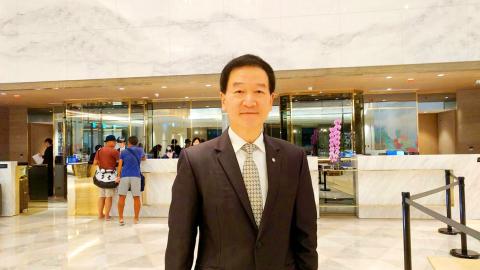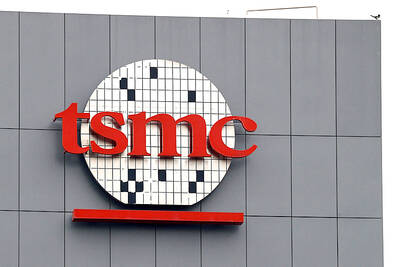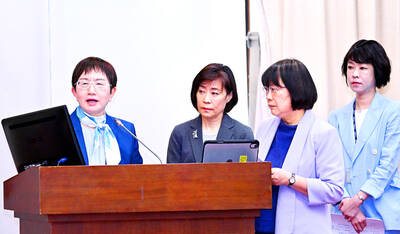Taipei Times (TT): A new hotel opened every two days in the first half of this year, while occupancy and room rates declined. Is it a good time to launch the new hotel, especially in Taipei’s old community of Wanhua District (萬華)?
Gary Pi (皮金營): Our affiliate, Hung Kuo Group (宏國集團), a Taipei-based developer, won a build-operate-transfer contract from the Taiwan Railways Administration years ago to develop three land plots on the former site of the Wanhua Railway Station.
The project is part of the city government’s effort to revive western Taipeim which has lost its luster to eastern Taipei and Xinyi District (信義) over the decades.

Photo: Crystal Hsu, Taipei Times
The renewal project includes two high-rise buildings and a parking tower connected by overpasses. The city government will keep most of the space in one mixed-use building and allow the group to run a hotel in the other.
Demand for hotel rooms far outpaced supply at the time of signing.
It cost NT$6.5 billion [US$214.3 million] to build the new hotel, the first and only star-grade facility in the area.
It has 30 floors above ground and no basement because it sits above the Wanhua Railway Station. Guests can park in the adjacent parking tower or use the Taipei Mass Rapid Transit System, as MRT Longshan Temple Station is only a three-minute walk away.
The group decided to operate the hotel under a new brand, Caesar Metro Taipei Hotel (台北凱達大飯店), to differentiate it from Caesar Park Taipei (台北凱撒), Caesar Park Banciao (板橋凱撒) and other competitive facilities.
With 745 guestrooms, Caesar Metro is the second-largest facility, second only to the Grand Hyatt Taipei (台北君悅大飯店), which has more than 800 rooms.
TT: How will you carve a market for Caesar Metro with the sector already crowded and more players joining?
Pi: Caesar Metro aims to emulate the W Hotel in Xinyi District in both popularity and occupancy in western Taipei, where existing facilities are relatively small.
The city government has tried to draw crowds away from Xinyi District and revive Wanhua District, which used to be the city’s most bustling and crowded area half a century ago.
We expect Japanese travelers to make up 40 percent of Caesar Metro’s guests and travelers from Hong Kong, Singapore and South Korea to contribute another 40 percent. Domestic travelers might fill up the remaining 20 percent.
We are reaching out to business and leisure travelers home and abroad, and are cooperating with traditional and online travel agencies.
Having a new lodging facility is a competitive advantage in itself and we aim to impress guests with five-star service and amenities at an affordable rate of NT$3,500 per night, about half the price of similar accommodation in Xinyi and Zhongshan districts (中山).
We will have more than 460 Japanese, English and Korean-speaking employees to help achieve the goal.
Caesar Metro will also benefit from synergy as a member of Caesar Park Hotels and Resorts (凱撒飯店連鎖), will soon be the largest hotel chain in Taiwan with more than 2,000 guestrooms, almost double the current number.
TT: Have you set business targets for Caesar Metro this year and beyond?
Pi: We aim to achieve an occupancy rate of between 50 and 60 percent in the first 12 months and an annual revenue of between NT$1.2 billion and NT$1.3 billion from the second year onward.
The goals, if realized, would allow the group to recover the investment in seven years, thanks to the absence of land acquisition costs.
To help create a purpose, Caesar Metro has a Western buffet restaurant and a Chinese restaurant that can seat 327 and 270 guests respectively. We also have large conference rooms that can host banquets and an outdoor swimming pool, a lounge bar and a fitness center, although they could not be completed in time for the soft opening.
Wanhua District is home to such tourist attractions as Longshan Temple (龍山寺), Bopiliao Historical Block (剝皮寮歷史街區) and Huasi Street Night Market (華西街觀光夜市), better known as ‘Snake Alley.’ We hired more than 20 concierge staff to double as tour guides to help guests appreciate the historical attractions and local culture.
TT: What are your views about the industry as the group is to double its properties this year?
Pi: The market will face challenges in the coming few years, as it needs more time to assimilate the sharp decline in Chinese tourists, who drove 40 percent of overall inbound visits in 2015 and contributed 35 percent last year.
The pace of contraction rose to 40 percent in the first six months of this year. Overdependence on a single market is never healthy for any industry.
It will take more time for travelers from other nations to fill the shortfall, given their relatively small numbers. It is important to look at a business from a long-term perspective.
Taiwan is better suited for the development of travel and tourism industries than Hong Kong, Singapore or other places in the region, considering its diverse natural scenery and unique culture and food.
We believe tourism will account for a greater share of GDP and star-grade properties can survive the transition as long as inbound travelers hit 10 million a year.
Caesar Park Taipei, across from Taipei Main Station, has been able to achieve occupancy rates of more than 85 percent, despite economic cycles, thanks to its convenient location and diversified customer mix. We can copy the successful model at Caesar Metro.

SECTOR LEADER: TSMC can increase capacity by as much as 20 percent or more in the advanced node part of the foundry market by 2030, an analyst said Taiwan Semiconductor Manufacturing Co (TSMC, 台積電) is expected to lead its peers in the advanced 2-nanometer process technology, despite competition from Samsung Electronics Co and Intel Corp, TrendForce Corp analyst Joanne Chiao (喬安) said. TSMC’s sophisticated products and its large production scale are expected to allow the company to continue dominating the global 2-nanometer process market this year, Chiao said. The world’s largest contract chipmaker is scheduled to begin mass production of chips made on the 2-nanometer process in its Hsinchu fab in the second half of this year. It would also hold a ceremony on Monday next week to

TECH CLUSTER: The US company’s new office is in the Shalun Smart Green Energy Science City, a new AI industry base and cybersecurity hub in southern Taiwan US chip designer Advanced Micro Devices Inc (AMD) yesterday launched an office in Tainan’s Gueiren District (歸仁), marking a significant milestone in the development of southern Taiwan’s artificial intelligence (AI) industry, the Tainan City Government said in a statement. AMD Taiwan general manager Vincent Chern (陳民皓) presided over the opening ceremony for the company’s new office at the Shalun Smart Green Energy Science City (沙崙智慧綠能科學城), a new AI industry base and cybersecurity hub in southern Taiwan. Facilities in the new office include an information processing center, and a research and development (R&D) center, the Tainan Economic Development Bureau said. The Ministry

ADVERSARIES: The new list includes 11 entities in China and one in Taiwan, which is a local branch of Chinese cloud computing firm Inspur Group The US added dozens of entities to a trade blacklist on Tuesday, the US Department of Commerce said, in part to disrupt Beijing’s artificial intelligence (AI) and advanced computing capabilities. The action affects 80 entities from countries including China, the United Arab Emirates and Iran, with the commerce department citing their “activities contrary to US national security and foreign policy.” Those added to the “entity list” are restricted from obtaining US items and technologies without government authorization. “We will not allow adversaries to exploit American technology to bolster their own militaries and threaten American lives,” US Secretary of Commerce Howard Lutnick said. The entities

Minister of Finance Chuang Tsui-yun (莊翠雲) yesterday told lawmakers that she “would not speculate,” but a “response plan” has been prepared in case Taiwan is targeted by US President Donald Trump’s reciprocal tariffs, which are to be announced on Wednesday next week. The Trump administration, including US Secretary of the Treasury Scott Bessent, has said that much of the proposed reciprocal tariffs would focus on the 15 countries that have the highest trade surpluses with the US. Bessent has referred to those countries as the “dirty 15,” but has not named them. Last year, Taiwan’s US$73.9 billion trade surplus with the US